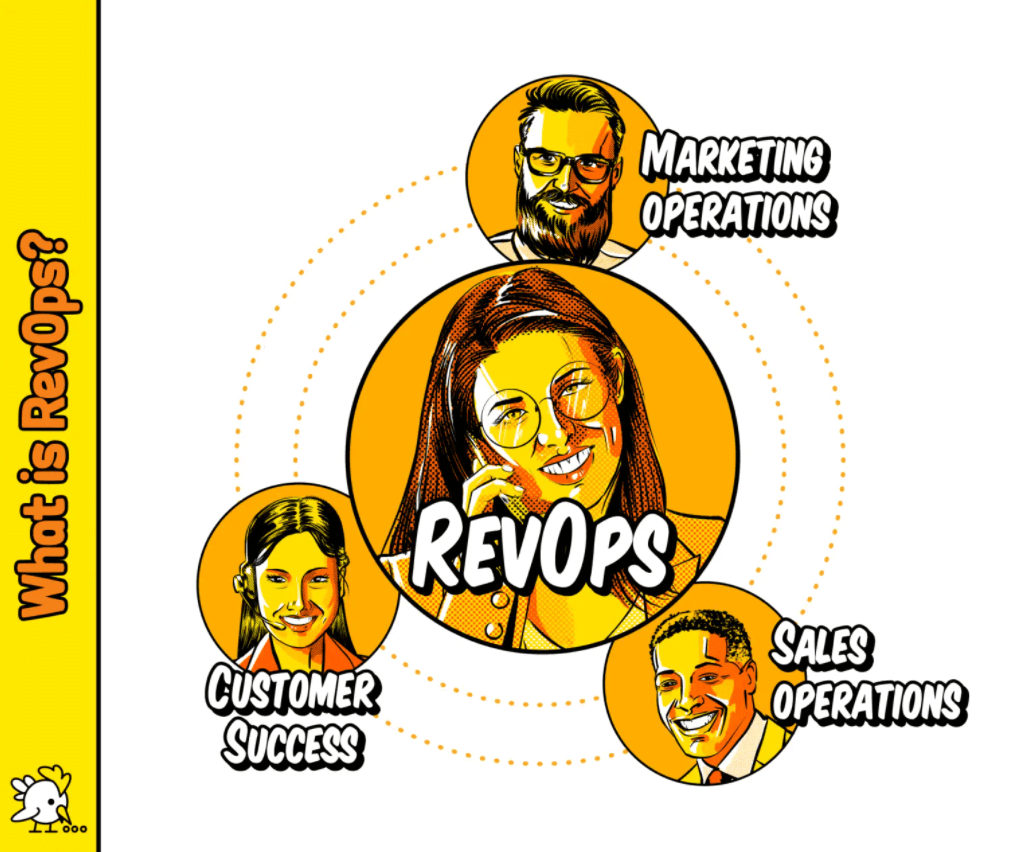Raise your hand if you’ve felt that your sales and marketing teams were competing against each other instead of working together as a cohesive unit to boost your bottom line.
Don’t worry. You’re not alone.
After all, your sales and marketing team often have different objectives, processes, and metrics. These factors alone can create friction and inefficiency.
But here’s the good news. There’s finally a solution that can break down those walls and keep all those important teams from working together.
Revenue operations (commonly abbreviated as RevOps for short) can help bridge that gap.
So, are you ready to unify and optimize the entire revenue cycle, from lead generation to customer retention?
This article explores how RevOps can be instrumental in aligning sales and marketing, the benefits of doing so, and how Breadcrumbs can help you implement a successful RevOps strategy.
Understanding RevOps
Let’s start by revisiting what RevOps is and why it’s important for businesses.
Definition of RevOps
RevOps stands for Revenue Operations, which is the alignment and integration of all the functions that contribute to revenue generation. These functions typically include sales, marketing, customer success teams, and operations.
Importance of RevOps in today’s business landscape
Revenue Operations is critical for modern businesses. It helps:
- Enable sales departments to hit their revenue goals ahead of time
- Turn businesses into revenue engines
- Achieve your business goals
But it also offers other more specific benefits.
First, it helps any business adapt to changing buyer behavior and customer expectations.
How? It enables you to deliver a consistent and personalized customer experience across all touchpoints, channels, and stages of the sales cycle.
Second, RevOps helps you measure and improve your revenue performance and outcomes. In other words, it provides a holistic and data-driven view of the entire revenue cycle, from lead to customer.
Finally, RevOps helps businesses of all sizes overcome the challenges of siloed and fragmented revenue processes and follow the same best practices across the board.
For example, a small company like Hims that focuses on men’s health and hair loss solutions can improve sales tenfold by applying RevOps best practices, such as:
- Analyzing their customer segments, personas, and pain points and tailoring their marketing, sales, and service messages and offers accordingly.
- Streamlining their online consultation and treatment process and ensuring a seamless and secure customer experience across different channels and platforms.
- Integrating their tools and systems, such as their website, CRM, email, SMS, and telehealth platform, and automating their workflows and communications to offer a completely online service.
RevOps: The bridge between sales and marketing
In this section, we’ll hone in on one of the most critical aspects of Revenue Operations, which is the alignment and optimization of your sales and marketing virtual assistants.
How RevOps helps align sales and marketing
The alignment and optimization of processes like sales and marketing, as facilitated by RevOps, play a vital role in driving revenue growth and are key outcomes of RevOps principles.
For example, in the financial sector, Revenue Operations can positively impact the synergy between sales and marketing, optimizing the offering and promotion of financial products like online debit cards, bank accounts, credit cards, and more.
But how does that work? And what do aligned sales and marketing teams look like?
Sales and marketing alignment means that both teams share the same goals, strategies, tactics, and tools to generate, nurture, and close leads and retain and upsell customers.
Building a Revenue Operations team can help achieve this alignment by:
- Defining a common revenue goal and a marketing and sales strategy that both teams agree on and are accountable for.
- Establishing a clear and consistent definition of the target market, buyer personas, customer journey, and ideal customer profiles (ICPs).
- Creating a unified and seamless lead management process, from lead generation to lead qualification and scoring to lead handoff and conversion.
- Implementing a shared and integrated tech stack enables both teams to access and leverage the same data, insights, and analytics.
- Aligning the content, messaging, and campaigns both teams use to attract, engage, and educate prospects and customers.
- Translating the content and making it accessible among various markets.
- Fostering a culture of collaboration, communication, and feedback between cross-functional teams with common goals and other revenue functions.
The benefits of alignment between sales and marketing through RevOps
Businesses that successfully align sales and marketing through Revenue Operations see significant benefits for both teams and the organization overall.
Some of these benefits are:
- Higher employee engagement and retention.
- Enhanced customer satisfaction and loyalty.
- Increased revenue growth and profitability.
- Improved efficiency and productivity.
- Lower customer churn rates.
In fact, according to a recent report by HubSpot, sales professionals are 104% more likely to reach or exceed their goals in organizations that have fully aligned sales and marketing teams. In those same organizations, marketers are 128% more likely to say their strategies are “very effective.”
Plus, according to 87% of sales and marketing leaders, strategic alignment of sales and marketing teams is the key to encouraging critical business growth.
Common missteps in RevOps and how to overcome them
While RevOps can be a powerful and transformative approach for aligning sales and marketing and expanding your revenue streams, it isn’t without its challenges and pitfalls.
Here are some of the common missteps that businesses make when implementing RevOps and how to overcome them.
Current state of sales and marketing alignment
Let’s start by looking at how well sales and marketing teams are aligned across different industries.
The same HubSpot report cited earlier states that only 35% of marketers and 30% of sales professionals in the UK say both teams are tightly aligned. That leaves out two-thirds of marketers and sales professionals who don’t believe their teams are strongly aligned.
But this is just an average for the UK. In other places like Sweden, things are far worse, with less than 10% of sales and marketing professionals admitting strong alignment.
Where alignment does occur, more than half (55.8%) of marketers and sales reps align regarding their conversation strategy when reaching out to leads or customers. However, only 31% align regarding analytics and metrics like key performance indicators or KPIs.
This study shows that there is still much room for improvement in sales and marketing alignment, as many businesses struggle with issues such as:
- Lack of collaboration, communication, and feedback between both teams, creating distrust, resentment, and conflict.
- Lack of a unified and integrated technology stack, causing data silos, discrepancies, and inefficiencies.
- Lack of a standardized and streamlined sales and marketing pipeline.
- Lack of clarity and mutual understanding of each other’s activities.
- Lack of agreement on the revenue goal and strategy (planning).
- Misalignment in goals and metrics.
The pitfalls of treating RevOps as Sales Ops 2.0
Among the challenges of sales and marketing alignment, one is ensuring the security and privacy of customer data across different teams.
Every person with access to customer data represents a security risk, so businesses must go above and beyond to add as many security measures as they can afford.
An effective and popular extra layer of protection is multi-factor authentication (MFA). MFA is a process of verifying the identity of a user (authenticating) by requiring two or more pieces of evidence, such as:
- A code sent to a phone
- A fingerprint scan
- A password
- Face ID
Technical challenges aside, though, one of the biggest mistakes that businesses make when implementing Revenue Operations is treating it as Sales Ops 2.0.
In other words, some managers think of RevOps as expanding the scope and responsibilities of the existing sales operations team to include marketing and customer success ops.
While this may seem like a logical and easy way to achieve RevOps, it can actually create more problems than solutions:
- It creates confusion and frustration, as the sales operations team may not have the expertise, bandwidth, or authority to handle the operations of other teams.
- It makes silos larger and extends them to entire departments instead of eliminating silos, which is what RevOps is all about.
- The latter, in turn, creates more inefficiency and ineffectiveness, negating any possible benefit RevOps offers.
Improving alignment
To avoid the pitfalls of treating RevOps as Sales Ops 2.0 and achieve true and lasting alignment between sales and marketing, you need to take a different and more holistic approach to RevOps, such as:
- Structuring people by specialty rather than by department means creating a dedicated and cross-functional RevOps team that consists of specialists from sales, marketing, customer success teams, and operations who work together to support and optimize the entire revenue cycle.
- Changing the C-Suite structure by elevating the role and influence of the RevOps leader and having them report directly to the CEO or the Chief Revenue Officer rather than to the heads of sales, marketing, or customer success operations.
- Appointing a strong operational leader responsible for overseeing and managing the RevOps team.
Breadcrumbs Strategy in RevOps
One of the key strategies that can help you implement a successful RevOps approach and align your sales and marketing teams is lead scoring using Breadcrumbs.
Work smarter, not harder, thanks to a powerful and innovative lead scoring and qualification platform that helps businesses generate, nurture, and convert more leads.
How Breadcrumbs can help
Breadcrumbs can help businesses with their RevOps strategy in several ways, such as
- Providing a comprehensive and actionable way to track and measure the performance and outcomes of the lead management process using real-time and data-driven insights and analytics.
- Providing a simple and intuitive way to score and qualify leads based on their behavior, engagement, and fit, using a combination of AI and human intelligence.
- Providing a seamless and automated way to hand off leads from marketing to sales, based on their readiness and priority, using smart and customizable workflows.
The role of Breadcrumbs in aligning sales and marketing
Breadcrumbs can play a vital role in aligning sales and marketing, as it helps both teams to:
- Share the same definition and understanding of the target market, buyer personas, entire customer journey, and ideal customer profile. Breadcrumbs provides clear, consistent criteria and a framework for scoring and qualifying leads.
- Handle their operations from a common platform, as Breadcrumbs integrates seamlessly with most existing marketing and sales tools and platforms, such as CRM, email, web, and social media.
- Share the same goal and strategy: to generate, nurture, and convert more qualified leads and optimize the lead-to-customer conversion rate.
Six steps to implement Breadcrumbs strategy in your RevOps effectively
To effectively implement the Breadcrumbs strategy in your RevOps, you can follow these six steps:
- Sign up for Breadcrumbs and connect it with your CRM and other tools that you use for lead generation and management.
- Define your objectives by identifying the specific segments of contacts that represent success in those objectives.
- Run Breadcrumb’s Reveal analysis of your CRM account to make sense of all the data in terms of value and need for enrichment.
- Align sales and marketing by working together to identify a common ICP from the insights derived from Reveal.
- Agree on what metrics are important for both sales and marketing.
- Create a lead scoring model using Breadcrumbs to prioritize the same leads for marketing and sales.
Case study: How Breadcrumbs helped Thinkific align sales and marketing
Thinkific is an online course platform that helps entrepreneurs create and sell their own courses.
Thinkific used Breadcrumbs to align sales and marketing, reducing their service level agreement (SLA) and Marketing Qualified Lead to Opportunity (MQL to OPP) rates dramatically.
The challenge
Thinkific had two main challenges to overcome, both related to misalignment between sales and marketing. Its sales team was inefficient and lacked trust in the quality of the leads coming from marketing.
The company also had a lot of data about its leads, but it was scattered, incomplete, and inconclusive. Marketing didn’t know who their best leads were, and neither did sales. Consequently, Thinkific’s SLA was slow, and its MQL to OPP conversion rate was too low.
Breadcrumbs as the solution
Thinkific implemented Breadcrumbs to surface the leads that are ready to buy in real time. It used Reveal to analyze its HubSpot data and provide insights on the value and impact of different lead categories.
Thinkific also aligned marketing and sales on the ideal customer profile and the metrics to focus on and used Breadcrumbs to score their leads based on fit and engagement criteria.
Thinkific’s results
Thanks to Breadcrumbs, Thinkific reduced their speed to lead times by 99%, from 2–5 days to 10 minutes. They also increased their lead quality, doubled their MQL to OPP rate in just 3 months after implementing their first lead scoring model, and improved their lead quality conversations and their acquisition strategy by using data-driven insights.
RevOps can bridge the gap between sales and marketing
In conclusion, RevOps is a strategic approach that can help your organization align and optimize your sales and marketing teams and achieve revenue goals.
It’s time to deliver a consistent and personalized customer experience and overcome the challenges of siloed and fragmented revenue processes. With RevOps, you create a single source of truth for all and can finally measure and improve revenue performance and outcomes.
If you want to learn more about how Breadcrumbs can help you with your RevOps strategy, book a demo with Breadcrumbs today!










